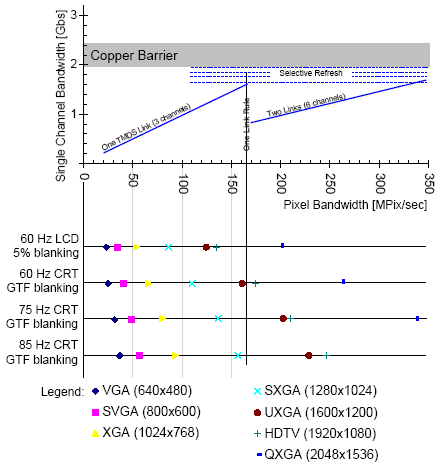The TFT Connection: Do NVIDIA and ATi Deliver?
Pixel Frequency
Blanking time is a very important factor when hooking up a TFT display using DVI, since every resolution requires a certain bandwidth from the transmitter (graphics card). The higher the desired resolution is, the higher the pixel frequency of the TMDS transmitter has to be. The DVI standard specifies a maximum pixel frequency of 165 MHz (Single Link). Thanks to the ten-fold multiplication of the frequency described above, this results in a peak data rate of 1.65 GB/s, which is enough for a resolution of 1600x1200 at 60Hz. If higher resolutions are required, the display would need to be connected via Dual Link DVI, which uses two DVI transmitters together resulting in twice the bandwidth. We will go into more detail on Dual Link further on in the article.
However, the simplest and cheapest solution consists of reducing the blanking data instead. The result is that more bandwidth is available for the graphics data, meaning that even a single DVI transmitter at 165 MHz is capable of displaying higher resolutions. Another option is to reduce the refresh rate.
The upper part of the chart shows the resolutions that a single DVI transmitter operating at 165 MHz can display. Reducing the blanking data (middle) or the refresh rate (Hz) allows for higher resolutions.
This illustration shows which pixel frequency is required for a certain resolution. The upper row shows a TFT operating with reduced blanking. The second row (60Hz CRT GTF Blanking) shows the bandwidth a TFT requires if it does not support reduced blanking.
Get Tom's Hardware's best news and in-depth reviews, straight to your inbox.
-
Thanks for this. Saved me lots of trouble with (not) chosing an incompatible DVI cable for my monitor / computer connection.Reply

